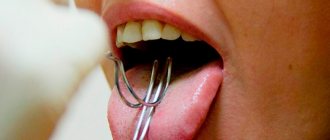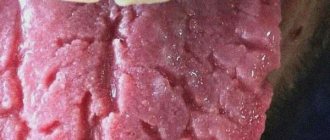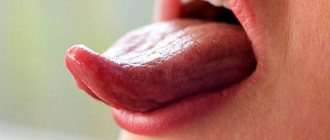.
A tiny patch of skin under the tongue can sometimes cause a lot of problems and worries. We are talking about a frenulum that is attached under the tongue. The pronunciation and clarity of speech, as well as comfort when eating, depend on its location, length and elasticity. This delicate membrane can quickly regenerate, but you should not neglect timely treatment measures if you receive an injury to the frenulum of the tongue.
The frenulum of the tongue is responsible for its movement. Shortened frenulum - pronunciation defects
A little about the complexities of the anatomy of the tongue
The frenulum of the tongue is a thin bridge that connects the lower part of the oral cavity to the tongue. Its main function is to maintain the correct position of the tongue in the mouth by ensuring its movement, which is directly related to diction and the ability to pronounce individual sounds.
To see the frenulum, it will be enough to lift the tongue upward. It is located in the middle of the tongue, connecting to the base of the gums, as if holding this organ in place.
A normal frenulum does not cause discomfort
The length of the frenulum of an adult is approximately 3 cm. If this figure is less or the frenulum of the tongue is located in such a way that when it is raised, it is strongly stretched, we can talk about a short frenulum. In turn, it will interfere with the free rotation, protrusion and elevation of the tongue.
A short hyoid frenulum is a congenital developmental anomaly in which the tip of the tongue is sharply fixed closer to the bottom of the oral cavity. In this condition, a child from early childhood may have problems sucking the mother's breast, and over the years the anomaly is expressed in the development of speech. There are two methods to combat this feature: surgical and speech therapy. But which one is better to choose for a child and is it possible to do without cutting?
According to the majority, a person has only one frenulum in the mouth - under the tongue, but this opinion is wrong. The frenulum is located both between the gum and upper lip, and behind the lower lip. All three have their own functions and require special attention, but today we’ll talk about the hyoid frenulum, its purpose and what to do in cases where it is short.
The frenulum of the tongue is a mucous membrane, which is a fold that connects the movable tongue and the fixed floor of the oral cavity. Its main purpose is to stabilize and reduce excessive activity of the tongue. The frenulum seems to soften the movements of the tongue and is a kind of limiter.
In the absence of deviations, the frenulum is located in the middle of the lower side of the tongue and fastens it to the sublingual area. It does not interfere with the movement of the tip of the tongue, but allows it to be fixed, leaving it mobile. The normal length indicators for the frenulum of the tongue are:
- for newborns - 8 mm;
- in children five years old - 17 mm;
- for adults - from 27 to 30 mm.
By 1.5 years, the length of the tip of the tongue, free from the frenulum, is 16 mm.
Signs of a short frenulum and its incorrect location
In addition to being too short, the frenulum may not be positioned correctly under the tongue. A mother may suspect a problem while breastfeeding. With a short frenulum, the baby may be capricious when attached to the breast. He throws his head back and arches. For this reason, feeding may be frequent and prolonged, with rest breaks. The baby may bite the breast, make clicking noises, or refuse the breast altogether. As a result, the baby may experience underweight.
Older children and adults with a short or incorrectly positioned frenulum may have difficulty pronouncing letters such as “r”, “l”, “d”, “t”, as well as sibilants. Problems such as malocclusion and difficulty chewing solid foods may also occur. A person with a short frenulum cannot or finds it difficult to reach the lips and palate with the tip of his tongue, as well as stick it out of the mouth. In order to eat normally, he has to put food closer to the root of his tongue.
Types of anomalies in the development of the frenulum:
When choosing the right method for correcting a frenulum, it is important to consider its type, of which there are only five.
- The bridle is practically absent. It is tightly intertwined with the muscles of the tongue and is practically part of it.
- There is a frenulum, but it is short and seems to merge with the muscles of the tongue. This type is often diagnosed with cleft lip and palate.
- Thin and transparent. It only slightly interferes with the movements of the tongue.
- Translucent and thin. As her tongue rises, she splits the tip into a heart shape.
- Opaque thick frenulum. When you try to reach forward with your tongue outside the mouth, its tip curls up, while the back part is raised.
Should I stretch my bridle or trim it?
Treatment of a short frenulum of the tongue is carried out using three methods:
- speech therapy;
- surgical;
- surgical and speech therapy.
The treatment method should be selected exclusively by a dentist, and not a speech therapist. However, before making a decision, I recommend listening to the opinions of both experts. Indications for the surgical method are difficulties in feeding the baby, as well as the formation of an incorrect bite. Usually this disease can be detected by a doctor during an examination of the child in the maternity hospital. An operation is also performed there, which is considered painless.
If a short frenulum is detected by such signs as incorrect pronunciation of letters, then most often the defect can be overcome by stretching the membrane with the help of classes with a speech therapist. In some situations, plastic surgery of the sublingual fold is prescribed. And after healing, the doctor can prescribe speech therapy exercises with a specialist, which prevent the development of incorrect speech habits.
Most often, if the frenulum is positioned correctly relative to the tongue and has normal thickness, then the problem can be solved without surgery by working with an experienced speech therapist, doing exercises and using special massages for the tongue.
Why does the frenulum hurt?
Tongue diseases are a fairly common problem, but most often quickly solved. The main thing is to choose the right treatment by contacting an experienced specialist.
The mucous membrane under the tongue is highly sensitive; therefore, it can become inflamed and painful even in those people who have never experienced problems with it. It reacts to all kinds of irritants and is also easily damaged.
An abnormal frenulum is injured more often
Causes of pain in the frenulum of the tongue:
| Mechanical injury | When eating solid food or using sharp instruments, there is a possibility of damage to the mucous membrane. |
| Inflammation of the lymph nodes | A number of infectious diseases can lead to inflammation of the submandibular lymph nodes, which will be expressed by pain symptoms in the area of the mucous membranes of the mouth. |
| Allergic reactions | Allergies can be caused by medications, personal care products (toothpaste, mouth rinses) or food products, and the body's reaction will be pain. |
| Overload of the speech apparatus | Loud screams, prolonged conversations and singing can cause an unpleasant feeling of soreness in the frenulum. |
Quite often, pain in the tongue can be echoes of problems in various human organs - the esophagus, teeth and salivary glands.
A lack of vitamins and minerals provokes the development of anemia, a lack of nutrients and B vitamins can also negatively affect the health of the oral mucosa.
An abscess near the frenulum can lead to injury
One of the key rules for pain in the frenulum is not to ignore these painful sensations, because the delicate and sensitive tissues under the tongue perform functions necessary for the body. And it is always easier to prevent a disease than to deal with its consequences and complications.
Possible triggers
Other possible causes of pathology are:
- Chronic inflammatory diseases of the penis
. Balanitis and balanoposthitis, in most cases occurring with the presence of pathogenic microflora, lead to structural tissue changes in the area of the head of the penis. - Chronic injuries to the foreskin
. Even microdamages to the delicate skin of the penis without proper and timely response can lead to improper tissue fusion. Such injuries occur when playing certain sports or wearing too tight underwear and clothes. - Diabetes mellitus in the stage of decompensation
. In this case, tissue changes are caused by a characteristic sign of the disease - a disruption of the regeneration process, as a result of which cicatricial deformities begin to appear in the tissues of the frenulum.
Most often, the pathology is diagnosed when a man begins to have an active sexual life. That's when the real problems begin. Especially if the disease is not detected and treated in time.
Causes of frenulum rupture
Life is filled with different situations in which you can break the frenulum of the tongue. This often happens as a result of:
- injuries - for example, from a fall;
- impact - hitting your face can cause injury to the frenulum;
- sudden movement of the tongue.
If there is a small tear in the frenulum, there is no need to panic; it will go away on its own after some time. If the gap is deep, you need to contact your dentist, who will tell you how to relieve the pain and, if necessary, prescribe treatment.
Severe injuries may require surgery.
Reasons for the development of pathology
In the vast majority of cases, a short frenulum is a consequence of a developmental abnormality and is combined with phimosis - a narrowing of the foreskin with the impossibility of exposing the head of the penis. According to statistics, up to 5% of uncircumcised men suffer from insufficient extensibility of the folds of skin on the penis. This anomaly is accompanied by a number of painful and unpleasant symptoms:
- curvature of the penis in an erect state;
- pain during sexual intercourse;
- premature ejaculation;
- the frenulum breaks as a result of active movements during intercourse.
With normal development, the frenulum is of sufficient length and can stretch significantly, providing comfortable and painless movement of the foreskin. A fold of skin that is too short causes a lot of trouble and can cause serious complications.
What to do if the frenulum is torn under the tongue
Injury and rupture of the frenulum can occur when its length is limited and there is insufficient elasticity. Getting this injury is not so easy, but it is possible when using sharp instruments or falling.
There is a certain list of actions that must be followed in order for this injury to pass without consequences for the body.
An injured frenulum definitely requires treatment
Rinse your mouth. Just clean, preferably cold water will do. If there is bleeding, the mouth should be rinsed with an antiseptic solution. This could be hydrogen peroxide, furatsilin, chlorophyllipt or maraslavin. You can also make a solution using baking soda, at the rate of 1 teaspoon of soda per glass of water.
To reduce pain, cotton swabs soaked in a lidocaine solution will help. Simply apply a tampon to the site of injury and the pain will noticeably decrease after a short period of time.
Minimize the load on the speech apparatus until complete healing.
To avoid re-rupture and microcracks, it is better to remain calm during the healing period.
Furacilin for rinsing is an effective remedy
Avoid consuming too hot or cold foods, as well as dry and rough foods. In the daily menu, it is better to use dishes with a liquid consistency, soft, not hot foods.
Surgical suturing of an injured frenulum
Local antiseptics are useful - trachysan, furatsilin, etc. The form of action is convenient for you: lollipops, spray, solution.
By taking a course of vitamins, recovery will be faster. It is recommended to adhere to the rules of personal hygiene; it is better not to touch the rupture site with your hands or apply pressure.
If the rupture site does not heal for a long time and causes discomfort, you should consult a doctor.
Surgical treatment of an injured lower frenulum
An experienced specialist will help relieve pain and prescribe, if necessary, adequate treatment.
Laser treatment - modern technology
At what age is it better to have frenuloplasty?
The sooner an anomaly in the shape and structure of the frenulum is identified, the more painless the operation to correct it will be. Accordingly, there will be many times fewer unpleasant consequences for the body.
- infancy: this is the best option. The pathology is usually diagnosed in the maternity hospital during examination of the newborn. At the age of up to 9 months, the membrane of the tongue has not yet had time to acquire blood vessels and does not have nerve endings, which means that the procedure for its correction will be quick and painless. The baby will almost immediately begin to eat well and stop being capricious. In children who have undergone frenuloplasty before one year of age, their appetite is quickly restored, since the sucking reflex is not impaired,
- 1-3 years: this period is the best time to visit the dentist for the first time; he will be the one who will be able to diagnose the problem and take action. Trimming the frenulum at this age will also be quite painless and will not harm the jaw system,
- 5-8 years: if the pathology of the frenulum was not resolved at an earlier age, then this can be done when the baby teeth fall out, but it is better before the baby teeth are replaced with permanent ones. A specialist needs no more than ten minutes to eliminate the pathology. But it is worth noting that at this age the child can already speak, which means he will have to additionally visit a speech therapist to retrain the baby to pronounce a number of sounds.
Help from traditional medicine
Using folk recipes and solutions, you can disinfect wounds without resorting to pharmaceuticals. In addition, many of them promote rapid healing of wounds and reduce pain.
Sage tincture. An excellent assistant in the fight against pain during the treatment of various oral injuries. To obtain a miraculous decoction, you need 2 tbsp. pour sage with 2 cups of boiling water and leave for about half an hour. You can rinse 5-10 times a day or as needed.
Sage tincture for rinsing - an effective folk remedy
Chamomile tincture. Chamomile has long been known for its antimicrobial properties. 1 tbsp of dried flowers of this plant is poured with boiling water and infused for 30-40 minutes. The broth must be filtered and used as a rinse solution several times a day.
Bedstraw decoction. This decoction can be used as a tea or rinse. Pour a tablespoon of herb into 1 cup of boiling water and leave for at least 30 minutes.
Alcohol tincture of St. John's wort. It is necessary to prepare 5 parts of 40% alcohol and 1 part of dried St. John's wort herb, let it brew for a while. After this, use 25-30 drops of tincture per glass of water and rinse. This is an excellent remedy for injuries to the tongue and oral cavity.
Using folk recipes, you can save a lot, and the result sometimes exceeds all expectations.
Stages of frenuloplasty
The procedure is quite simple and does not take much time. Using a scalpel or surgical scissors, the doctor will dissect the film. In children, this process does not even require pain relief; in older children, topical anesthesia is used. It is worth remembering that the older the child, the thicker the frenulum, so more time will be required for rehabilitation.
In the case of a short or long frenulum of the lip, the procedure will take more time. It must be performed under general anesthesia (deeper infiltration rather than superficial). If the frenulum is too bulky, the doctor will remove some of the tissue and apply stitches. If, on the contrary, it is short, dissection of the mucosa and even its partial transplantation will be required.
A few hours after the procedure, when the anesthesia wears off, pain and some discomfort are possible, but the edges of the wound are quickly covered with a thin film of epithelium, and the scar from the procedure disappears in a maximum of a couple of weeks.









